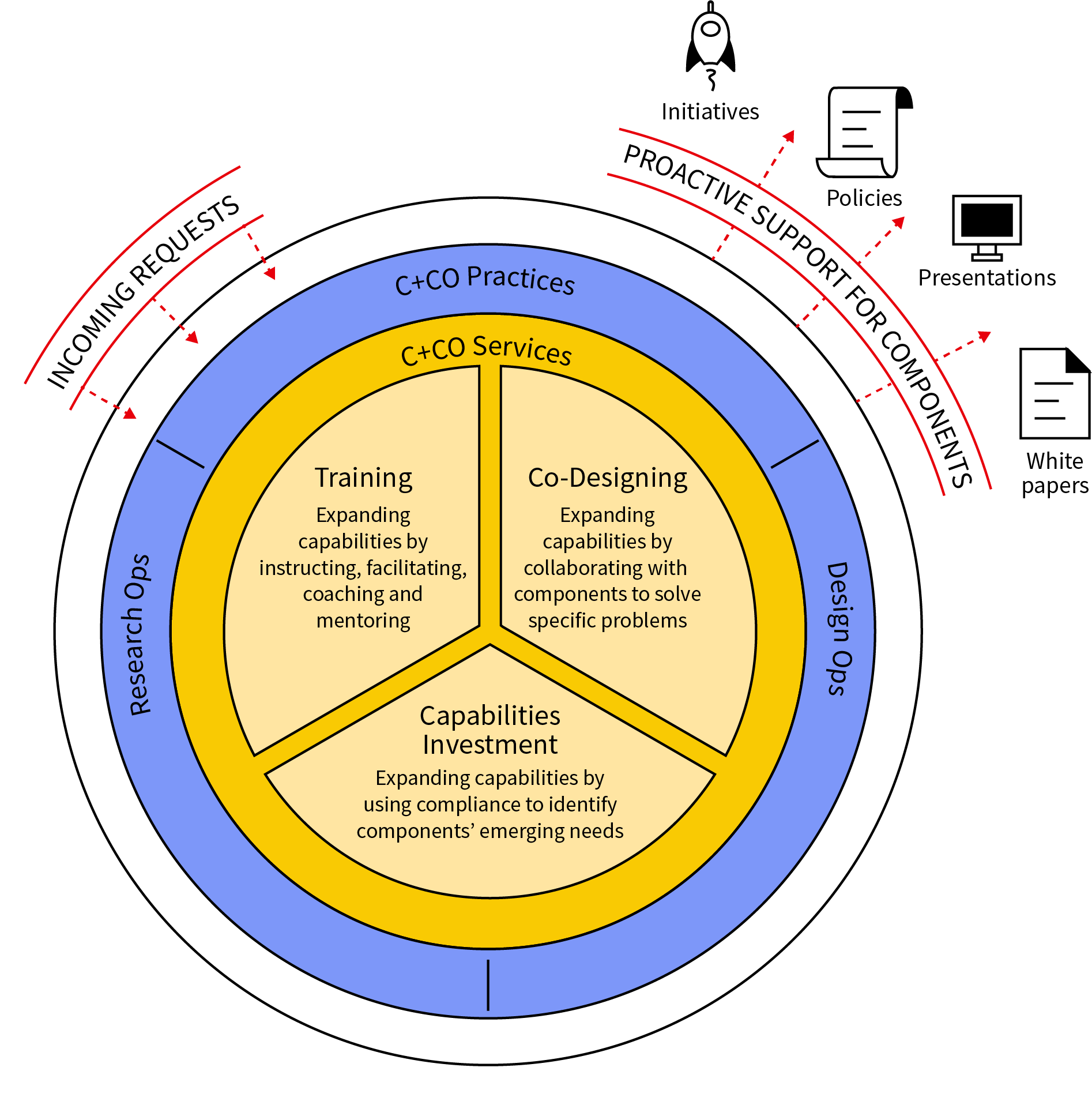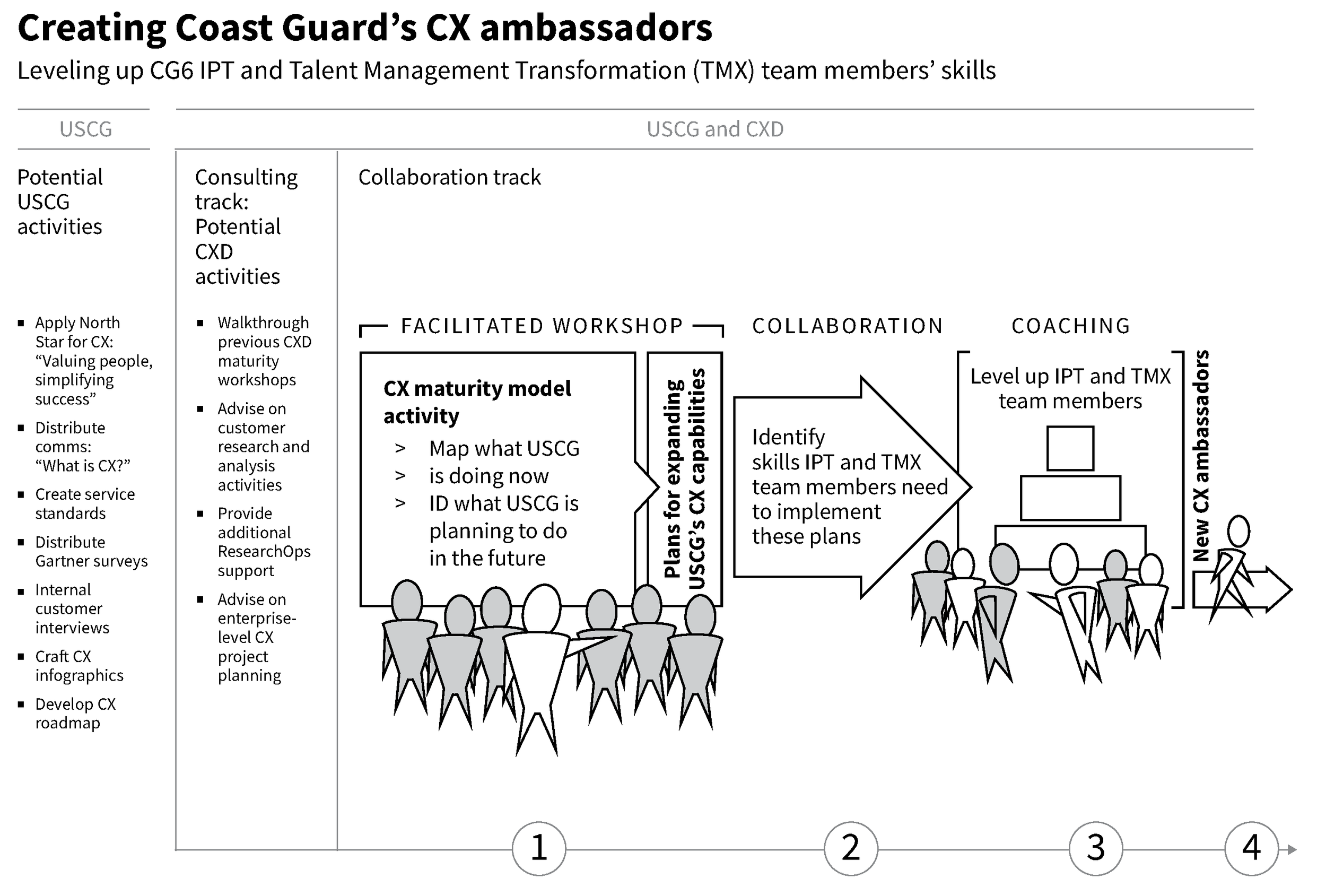Case studies
Aligning C+CO
Collaborative human-centered design activities work for everybody, even HCD professionals.
A CASE STUDY
My role
Silos in the federal government are insidious, even for the people charged with knocking them down. CX professionals, who often have to remove (or at least reduce) procedural and cultural barriers in order to get organizations to re-center around the needs of customers, can be victims of their own stovepiping.
When DHS’s Office of the Chief Information Officer established its Customer Experience Directorate (CXD) in 2023, the lines of work that separated its divisions were not well defined. By the time I joined the Capacity and Capability Operations Division (C+CO) a couple of years later, people were largely working in isolation. Teams-of-one were common and collaboration between the divisions was limited.
As a result, efforts and activities across CXD, and within C+CO, overlapped haphazardly. This led to inefficiency, frustration and tension.
Solution: Let’s draw a picture together
A model developed collaboratively by the Capacity and Capability Operations Division.
When I started as a branch chief, I treated my onboarding like it was a project and I interviewed my new CXD teammates like they were project stakeholders. I heard about many efforts underway that were similar, but disconnected. I heard complaints about teammates and leadership. I felt the tension of things gone unsaid and sensed the emotional scar tissue that had built up quickly in the directorate’s short existence.
My process to explore and address these issues:
Active listening: I talked to CXD staff, my fellow branch chiefs and CXD’s directors, collecting data without judgement or analysis.
Analysis: Once I had what felt like a critical mass of information, I looked for emerging themes and started playing around with the idea of an operating model for the work of C+CO. (What I really wanted to do was to collaborate with the directors and branch chiefs to come up with a CXD operating model, but as a new person stepping into a contentious environment, I didn’t see a path where that would have been successful.)
Iteration
Hypothesis: I sketched an initial version of a potential operating model. I tried to leverage words and concepts common to CXD, without being bound by them. (I tried to keep in mind that quote attributed to Albert Einstein: “We cannot solve our problems with the same thinking we used when we created them.”)
Collaboration: As soon as I had the first lines on a screen, I started to bounce the model off some of the same folks I had interviewed earlier, both one-on-one and in small groups. The model got better with each review and revision. It’s a process that’s worked well for me over the years in a wide variety of organizations. Rather than using a visual artifact to sell one of my ideas, I use drawing as a common way for different people to talk about the same concept.
Distribution: We iterated on the model until I had the full buy-in of my fellow C+CO team members. Then I walked through it with the CXD branch chiefs outside of my division. Then I shared it during any conversation within CXD where it seemed relevant. (Heck, if I thought anybody would wear them to work, I would have silk-screened the diagram onto t-shirts.)
Impact
By the end of this process, folks in C+CO were talking about themselves as members of a team rather than as individual contributors. They seemed to better understand each other’s work, which led to more collaboration. The model gave us a way to evaluate incoming and potential work.
Operationalizing CX for the U.S. Coast Guard
Co-designing solutions with the U.S. Coast Guard to improve the experiences of their internal customers.
A CASE STUDY
My roles
Consultant
The CX executive order (Executive Order 14058 Transforming Federal Customer Experience and Service Delivery to Rebuild Trust in Government) has had a powerful effect on federal agencies since it was signed in 2021. Each DHS component has followed their own path to compliance and as a result, DHS headquarters’ role in their maturity has been varied.
When an integrated product team the U.S. Coast Guard set up to improve customer experiences struggled, the team’s leadership asked the Customer Experience Directorate for help.
Solution: Expand the human-centered design capabilities of team members with hands-on human-centered design work
Few on the Coast Guard’s team of “CX ambassadors” had been exposed to customer experience work and they came from widely different backgrounds. The Coast Guard’s original ask was for simple training to introduce a common vocabulary, but I convinced them that a more aggressive approach was necessary.
The high-level project plan
I facilitated a series of discussions where we developed a three-part process with my team of CX professionals to help the Coast Guard team expand its capabilities:
In a facilitated workshop, collaborate with the Coast Guard team to map the organization’s capabilities, teaching them how to apply DHS’s CX maturity model. Expand their existing plans for expanding CX capabilities based on the new information.
Identify the gap between what the team needs to accomplish and their individual ability to accomplish it. Co-design a curriculum to fill that gap.
Level up each team members’ skills.
Impact
Rather than taking a top-down, system-centric approach to this challenge, we looked at it from the perspective of the new CX ambassadors. In other words, we used human-centered design activities to address the expansion of each team member’s human-centered design skills. The approach gave the team’s leadership a new way of looking at their challenges.
When circumstances shifted radically during the first 100 days of the new administration, the Coast Guard had to adjust both its strategies and tactics for improving customer experiences. We weren’t able to implement the original plan, but it served as a foundation for the plans that followed.
Maturing CX Capabilities at the Department of Labor
The Department of Labor’s workers compensation programs were very customer-oriented, but lacked the tools for collecting or analyzing their customers’ needs.
A CASE STUDY
My roles
Business development
Consultant
Researcher
Workstream lead
The Department of Labor asked Centers of Excellence (CoE) to help the Office of Workers' Compensation Programs (OWCP) improve the experiences of their many customers. I designed an engagement with three OWCP programs:
The Federal Employees’ Compensation Act (FECA) program serves injured or ill federal employees. Beneficiaries of the program are Federal Bureau of Investigation agents, postal workers, office workers, emergency responders, forest rangers, air traffic controllers, firefighters, Capitol police officers, and many others.
The Black Lung program supports coal miners, construction workers, and transportation workers who are regularly exposed to respirable coal mine dust and who have black lung disease.
The Energy program serves current and former nuclear weapons workers who have been exposed to radiation or other toxic substances.
I led the team that interviewed program staff and leaders to better understand the programs’ services and talked to the customers who rely on program services. The team evaluated programs based on the CoE CX Maturity Model. (I designed the model to define capabilities based on core CX functions.)
The three programs have made progress in measurement capabilities, tracking customer satisfaction and collecting performance-based metrics for timeliness, but overall, they lack human-centered design and customer experience expertise. Collecting, analyzing and widely distributing customer-related data is also an area of potential growth.
Outcome
We collaborated with staff and leadership to develop strategies and tactics for getting each of the programs to the next level in the CX Maturity Model. Four primary strategies emerged:
Share CX expertise across OWCP programs
Share tools across OWCP programs
Search engine optimization
Help the programs with their own strategies and tactics
Introducing Human-Centered Service Development
What started as a challenging customer experience engagement quickly expanded into an ambitious and innovative product development solution.
A CASE STUDY
My roles
Engagement lead
Product development lead
Workstream lead
The Treasury Department’s Alcohol and Tobacco Tax and Trade Bureau (TTB) collects taxes on alcohol, tobacco, firearms and ammunition. For more than two decades, TTB’s Office of the Chief Information Officer developed services with limited involvement from the rest of the bureau. The organization became less and less able to identify or address its customers’ needs as a result. An opportunity to rethink service development came with the retirement of the long-time CIO, but early efforts faltered.
Hoping to bolster their nascent service development efforts, TTB asked CoE’s help to expand their customer experience capabilities and create an environment where innovation would be more easily adopted.
Solution: Introduce service development that focused on satisfying customer needs
After interviewing a long list of TTB stakeholders, I came to believe that TTB’s resistance to innovation and lack of connection to customer needs were symptoms that could best be addressed with a new approach to developing services. I recommended a shift in the project’s scope to focus on their faltering service development efforts.
I supervised a team of contractors who conducted customer research, created customer archetypes and developed prototypes.
I supervised a team of contractors who conducted customer research, created customer archetypes and developed prototypes.
I assessed the maturity of TTB’s customer experience capabilities. I designed and facilitated an online workshop where staff and leaders from across the bureau created research-based journey maps
Impact
TTB started rolling out a new service development system as we were closing out our engagement. I collaborated with TTB stakeholders to create roadmaps for the delivery of services and the maturing of customer experience and product development capabilities. I also brought in another group from GSA to discuss how best to introduce product management expertise to support the new system.

